Inventing a Sacred Geography
Jerusalem’s ‘Stations of the Cross’
Why waste a good yarn?
“The cult of Cybele was well-known for its flagellant, mendicant priests and for the public ceremonies of 15-27 March when, after fasting and the Day of Blood (22 March) on which Attis was mourned, sorrow was turned into joy with the Hilaria celebrating his resurrection on 25 March (a striking parallel to the Christian Holy week and Easter).”
– Henry Chadwick, The Early Church, p24,25.
The streets of the Via Dolorosa were never traversed by Jesus, with or without his cross. The roads of the Old City of Jerusalem follow the line (but at a level some ten to fifteen feet higher) of the town built by the Roman Emperor Hadrian after 135 AD – a century too late for any Christian messiah.
The “stations of the cross” along the pilgrim route – originally seven but now fourteen – are entirely bogus and have always served a liturgical and commercial purpose. Even the route itself, from west to east, is at odds with current New Testament scholarship which favours a short south-north route from the area of Herod’s palace.
Five of the current “stations” are actually within the Church of the Holy Sepulchre, which offers the curious tourist and the wide-eyed believer a rich assortment of religious memorabilia, little of which is ancient. In the marble floor of the Catholic chapel a star marks the very spot where Mary Magdalen received the news of the resurrection from an angel, a medieval innovation. A “stone of unction” near the main door, where Joseph of Arimathea anointed the Lord’s body, was introduced by Crusaders in the 12th century. The latest chunk of red granite arrived in 1810 but it still gets kisses from the faithful. Even more startling, “Holy fire” descends each Easter into the sacred tomb, a “miracle” invented in the 9th century and yet the trick still delights the crowds.
Protestants may blanch at the chicanery and sacrilege of it all but for the Catholic and Orthodox creeds the circus is living proof of their faith and unwavering testimony of the “historical Jesus”.
Following the yellow brick road

The grid layout of the roads of Roman Aelia determines the streets of the Old City of Jerusalem even today. The 16th century Ottoman wall runs obliquely top left, Temple Mount intrudes lower right.
The Crusader-built Church of the Holy Sepulchre overlays part of the much larger 4th century Constantinian church; both are contained within the precinct of Hadrian's 2nd century temple of Venus/Aphrodite.
Opposite the Russian Hospice, the Lutheran Church of the Redeemer sits above a corner of the ancient forum.
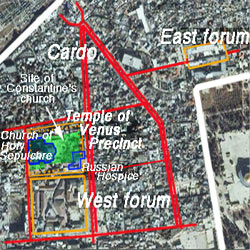
Aelia, city of the Pagans, lies under the city of the Christians and the Jews
Aelia was probably not a walled city while the 10th legion remained in residence and its full extent is uncertain. It is often described as a smaller city than its predecessor but in fact it may have extended north as far as Agrippa's third wall (Jodi Magness, Tufts University).
All fall down
The gospels make NO mention of Jesus falling three times (Stations 3, 7 and 9), no meeting with his mother Mary (Station 4), and no encounter with a woman named Veronica (Station 6). They are, in the parlance of religious chicanery, “devotional” embellishments. Even more farcical is the “prison of Christ”, close by the Convent of the Sisters of Zion, where the Lord was held for questioning. Not only is the “cell” medieval (the claim dates from 1911!) but it competes with another (equally bogus) “prison of Christ” within the Church of the Holy Sepulchre and a third in the so-called “house of Caiaphas” on Mount Sion!

JC's prison in the Church of the Holy Sepulchre. Not to be taken seriously!

JC's other prison on the Via Dolorosa, an authentic Jesus venue since 1911.
Perhaps Barabbas was in one cell and the Son of God in the other!
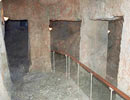
JC's other prison at the house of Caiaphas.



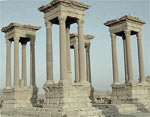
Tetrapylon from Palmyra – a road crossing, Roman-style.
Station 12 – The Greek Orthodox have possession of Calvary itself. The rock of Golgotha can even be touched, through a hole in bullet-proof glass. A touchy-feely experience not to be missed.

Oh my God – Holy Fire


Update, Christmas 2007 – Armenian Christians battle it out with Greek Orthodox. (Church of the Nativity, Nazareth).
The Via Dolorosa – A Sacred Topography
– Murphy-O’Connor, The Holy Land, p25.
– Murphy-O’Connor, p26.

The Holy Sepulchre – Catholic candles on the left, Armenian candles on the right, Greek Orthodox candles in the centre, holy baloney everywhere.
Laugh or Cry
Sources:
- Robert Gordon, Holy Land, Holy City (Paternoster, 2004)
- H. J. Richards, Pilgrim to the Holy Land (McCrimmons,1985)
- Shimon Gibson, Joan Taylor, Beneath the Church of the Holy Sepulchre (Palestine Exploration Fund, 1994)
- Joan Taylor, Christians and Holy Places: The Myth of Jewish-Christian Origins (Clarendon, 1993)
- Martin Biddle, The Tomb of Christ (Sutton, 1999)
- Jerome Murphy-O’Connor, The Holy Land (Oxford, 1986)
- Victoria Clark, Holy Fire (Macmillan, 2005)
- Karen Armstrong, A History of Jerusalem (HarperCollins, 1997)
Related Articles:

1st Station
2st Station


3st Station
4th Station

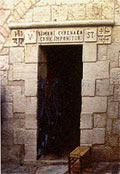
5th Station
6th Station
Buy your holy hanky here!
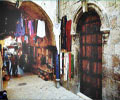
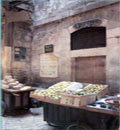
7th Station

8th Station

9th Station
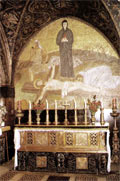
10th and 11th Stations

12th Station
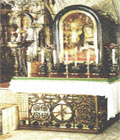
13th Station

14th Station
Within the Edicule, an ante-chamber (“Chapel of the Angel”) featuring the “Altar of the Rolling Stone.”
Heap big magic.
